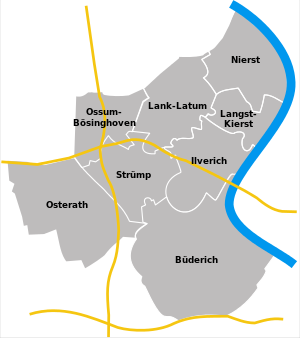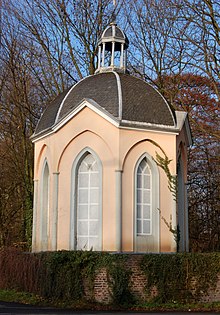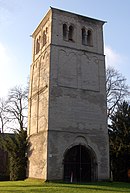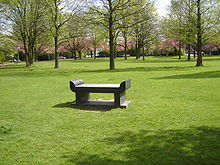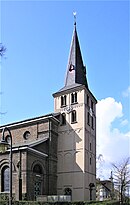Meerbusch
| coat of arms | Germany map | |
|---|---|---|
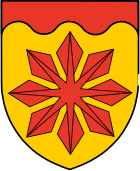
|
Coordinates: 51 ° 16 ' N , 6 ° 41' E |
|
| Basic data | ||
| State : | North Rhine-Westphalia | |
| Administrative region : | Dusseldorf | |
| Circle : | Rhine district of Neuss | |
| Height : | 36 m above sea level NHN | |
| Area : | 64.39 km 2 | |
| Residents: | 56,415 (Dec. 31, 2019) | |
| Population density : | 876 inhabitants per km 2 | |
| Postcodes : | 40667, 40668, 40670 | |
| Primaries : | 02132, 02150, 02159 | |
| License plate : | NE, GV | |
| Community key : | 05 1 62 022 | |
| LOCODE : | DE MRH | |
| Website : | ||
| Mayoress : | Angelika Mielke-Westerlage ( CDU ) | |
| Location of the city of Meerbusch in the Rhine district of Neuss | ||
Meerbusch is a city in the Rhein-Kreis Neuss in North Rhine-Westphalia .
Geography and religions
Geographical location
Meerbusch is located on the left Lower Rhine between Krefeld and Düsseldorf . The rural character is illustrated by the land use: around 3600 ha are used for agriculture or are fallow land , 540 ha are forest, 300 ha are water. Together, around 70% of the urban area is covered. The extension of the urban area is 12 km from north to south and 8 km from east to west. The greatest distance between the city limits is 12.5 km.
Neighboring communities
Adjacent neighboring communities ( clockwise , starting in the west) are Willich , Krefeld , Duisburg , Düsseldorf , Neuss and Kaarst .
City structure
The eight formerly independent municipalities of Büderich, Osterath, Lank-Latum, Ossum-Bösinghoven, Strümp, Langst-Kierst, Nierst and Ilverich make up today's districts.
| district | Residents | Area in hectares |
Area in percent of the urban area |
|---|---|---|---|
| Buderich | 22,411 | 1708 | 26.5 |
| Osterath | 13,022 | 1202 | 18.7 |
| Lank-Latum | 9,701 | 684 | 10.6 |
| Stocking | 6,169 | 620 | 9.6 |
| Ossum-Bösinghoven | 2,236 | 503 | 7.8 |
| Kidney | 1,408 | 722 | 11.2 |
| Langst-Kierst | 1,061 | 355 | 5.5 |
| Ilverich | 670 | 644 | 10.0 |
Denomination statistics
As of December 31, 2011, 22,979 or 41.3% Catholics, 12,763 or 22.9% Protestant Christians and 19,872 or 35.7% others or without a denomination lived in Meerbusch. As of December 31, 2016, 21,718 or 38.3% Catholics, 11,669 or 20.6% Protestant Christians and 23,291 or 41.1% others or without a denomination lived in Meerbusch.
history
The first traces of settlement in Meerbusch are the remains of the large Roman villa in Ilverich near the Limes in AD 70, another Roman villa on the Lank-Latum / Nierst border and a Roman villa found in Osterath. The Lank-Latum cemetery is Detectable since at least around 900. In 1001, the Meer Castle was built and high medieval clearing began. Hildegund von Meer founded a Premonstratensian monastery at Castle Meer in 1166 , which was opened in 1179 by Pope Alexander III. was recognized. In the period between 1388 and 1392, Linn Castle and with it the town and country, which also included the Meerbusch area, passed to the Archbishop of Cologne. Since 1422 the Archbishops of Cologne enfeoffed the Lords of Büderich with the Vogtei of Büderich.
The first archiepiscopal Cologne visitation to the Electorate of Cologne in 1569, and thus to the parishes of Büderich, Lank and Osterath, revealed religious abuses; Reformation ideas, however, were hardly widespread among the population. Because of their proximity to Düsseldorf , where the prelude to the Thirty Years War in the succession disputes over the triple duchy of Jülich-Kleve-Berg , the Meerbusch communities suffered from 1618 to 1648. During the Napoleonic occupation from 1794 to 1814, the left bank of the Rhine was incorporated into France ; Büderich, Langst, Lank, Osterath and Strümp became "Mairien" written in French. Through the Congress of Vienna , the former territories of Kurköln, the Grand Duchy of Berg, among others, came to Prussia and became its Rhine province . In 1842 the communities of Lank, Langst and Strümp were merged. The general revolutionary unrest of 1848/49 affected the Meerbusch communities only to a small extent.
In 1855, the main line of the Cologne-Krefeld Railway Company from Cologne via Neuss and Osterath to Krefeld was built, of whose distinctive stations the Osterather was one of the few remaining. In the course of industrialization, the first steam engine in the area was put into operation in Osterath in 1883 . In 1891 the Stein Brothers weaving mill and the Ostara mosaic factory started their work. The Stoessel wire rope factory followed in 1901 . In Lank and Latum, municipal lanterns were lit with electricity for the first time at Christmas 1900 . Osterath followed in 1903.
From 1919, later also during the Battle of the Ruhr from 1921 to 1926, the left Lower Rhine was occupied by Belgian and French soldiers. At times, over 6000 soldiers were stationed in the Meerbusch communities, including in the old disused electrical works in Osterath. With the municipal reorganization in 1929, Osterath and the Lank Office became part of the Kempen-Krefeld district; Büderich was added to the Grevenbroich-Neuss district. Local groups of the NSDAP were founded between 1930 and 1932 in Büderich, Lank and Osterath. In 1934 the Jewish cemetery in Osterath was desecrated and disposed of. The Jewish prayer house in Osterath was also destroyed during the Reichspogromnacht in 1938 . In 1941/42 37 Jews were deported from the Meerbusch communities, of which only three survived the genocide and returned. On March 1 and 2, 1945, American troops occupied Osterath, Büderich and the Lank office. In 1946 the citizens' committees were replaced by municipal councilors and mayors appointed by the Allied military government. Büderich, Osterath and the Lank Office became part of the newly founded state of North Rhine-Westphalia. In 1947 Protestant elementary schools were founded in Büderich and Osterath to take in the children of refugees and displaced persons.
In 1960 industrial areas were opened up in Strümp and Lank-Latum. In 1964 the sports stadium at Eisenbrand in Büderich was inaugurated. A general traffic plan in the Osterath community was first drawn up in 1966. With the area change treaty ratified in 1969 by the councils of the municipalities of Büderich, Ilverich, Langst-Kierst , Lank-Latum, Nierst, Ossum-Bösinghoven, Osterath and Strümp, the envisaged communal union received an initial basis, which was provided by the state parliament of North Rhine-Westphalia was passed in the Kempen-Krefeld Act . On January 1, 1970, the city of Meerbusch was founded, which was assigned to the then Grevenbroich district. The city was named after the Meerbusch forest area . The Quickborn planning team developed plans for Meerbusch's “New Center”. The state parliament of North Rhine-Westphalia decided on July 8, 1974 to dissolve the city of Meerbusch and to divide it into the cities of Düsseldorf (Büderich [main part], Ilverich, Osterath and Strümp [main part] as well as smaller parts of Langst-Kierst, Ossum-Bösinghoven and Willich), Krefeld (Langst-Kierst [main part], Lank-Latum, Nierst and Ossum-Bösinghoven [main part] and smaller parts from Strümp) and Neuss (smaller parts from Büderich). However, the city of Meerbusch obtained the suspension of the dissolution resolution at the Constitutional Court in Münster on October 8, 1974. On September 13, 1975, the State Constitutional Court declared the statutory provisions of the law for the reorganization of the Mönchengladbach - Düsseldorf - Wuppertal area, insofar as the city of Meerbusch was concerned, null and void. The state parliament of North Rhine-Westphalia then confirmed the existence of the city of Meerbusch on May 20, 1976. 94 members of the state parliament spoke out in favor of preserving the city, 92 against. The city name "Meerbusch" did not develop historically, but rather arose from resolutions in the course of the municipal reform. Originally the "new" city was supposed to be called "Rheinaue". Due to the fact that this place name already existed several times in Germany and no connection to the city's history could be identified, the name Meerbusch was chosen, which is based on the name of the former Haus Meer monastery and that of the Meerer Busch , a forest area.
In 1994 the “Forum Wasserturm” cultural centers and the Teloy mill in Lank were opened. A year later the foundation stone was laid for the new Malteser-Stift retirement home in Lank. The redevelopment of the center of Osterath began with Hochstraße in 1997. After the Higher Administrative Court approved the immediate completion of the A-44 Rhine crossing, work began in 1998 and was concluded with the inauguration of the bridge in 2002. The immediate implementation remained controversial because many Meerbuscher advocated the complete tunnel solution and others rejected the project entirely because of its effect on nature conservation.
politics
Meerbusch belongs to constituency 46 Rhein-Kreis Neuss III at the state level . Lutz Lienenkämper ( CDU ) was elected as a direct candidate for this position in the state parliament. At the federal level, Meerbusch belongs to constituency 111 Krefeld I - Neuss II . In the federal elections in 2009 , 2013 and 2017 was Ansgar Heveling (also CDU) elected as a direct candidate.
City council
| CDU | SPD | Green | FDP | UWG | left | center | Pirates | total | |
|---|---|---|---|---|---|---|---|---|---|
| 2014 | 24 | 10 | 6th | 6th | 3 | 1 | 1 | 1 | 52 |
| 2009 | 23 | 9 | 7th | 12 | 2 | - | 1 | - | 54 |
| 2004 | 25th | 10 | 6th | 7th | - | - | - | - | 48 |
mayor
Mayor of the city has been Dieter Spindler (CDU) since 1999 . In the local elections on August 30, 2009, he was re-elected with 49.03% (2004: 58.06%) of the vote. He did not run for the mayoral election in 2014. On May 25, 2014 Angelika Mielke-Westerlage (CDU) was elected as the new Mayor of Meerbusch with 58.2 percent of the valid votes.
Citizens' initiatives
The following citizens' initiatives exist in Meerbusch so far:
- Citizens' initiative "Pro Baum" against deforestation of trees as part of the renewal of the K9, Büderich local transit (founded in 2009)
- Citizens' initiative "Citizens against aircraft noise" , local group Meerbusch, against aircraft noise from aircraft taking off and landing at Düsseldorf Airport (founded in 2003)
- Citizens' initiative "Stop rail noise! For our health " against rail noise, especially the Neuss – Osterath – Krefeld line (founded in 2010)
- Citizens' initiative "Meerbusch-Nord against truck traffic" against truck traffic through Lank-Latum to the industrial areas at the Rheinhafen Krefeld (founded in 2010)
- Citizens' initiative against the construction of a power converter station at the Osterath substation (founded in 2012)
coat of arms
Blazon : "Under the red shield head in a wave cut, eight red leaves joined together in a star-shaped stem in a golden (yellow) field."
The coat of arms of the city of Meerbusch was approved by the district president on October 13, 1971; it has been used as a national emblem since the beginning of 1972, designed by the heraldist Waldemar Mallek. The wavy line stands for the sea part of the name , the eight-pointed flower wreath symbolizes the bush part of the name , embodies the merging of the eight parts of the city into one unit and indicates the growth and aspiration of the new city.
Town twinning
| City partnerships: | |
|---|---|
| Fouesnant in France, since 1968 | |
| Shijōnawate in Japan since 2010 | |
| City friendships: | |
| Wittenberge in Germany, since 1990 | |
| Blankenburg in Germany, since 1990 | |
The town twinning with the French town of Fouesnant in Brittany , called Jumelage by both sides , was established in 1968 between Fouesnant and the municipality of Strümp, the town of Meerbusch took over the partnership after the re-establishment. The first joint meeting of the councils of both cities took place in Meerbusch in 1988. The city's music school maintains friendly contacts with Kaustinen in Finland , and the city youth council runs an exchange program with Petach Tikwa near Tel Aviv . After German reunification , the council and administration of the city of Meerbusch supported the city of Wittenberge in Brandenburg and the city of Blankenburg am Harz with the necessary structural and administrative adjustments. A friendly contact is maintained with both cities. Since December 2010 there has been another city partnership with the Japanese city of Shijōnawate .
Regular events
Rock on the tower
The music festival “Rock am Turm”, which takes place annually on “Christmas Day” (December 27th), offers a stage in particular to young bands from the region and regularly attracts thousands of visitors. Due to the crowds, it was relocated from the Lank-Latum water tower to the “old boiler house” of the Büdericher Böhlerwerke. However, at the preliminary end of the series, the concert event returned to the water tower in 2008. A summer open air took place once in 2003 so far. In a rock and pop academy with the support of the State Music Council and the Ministry of Culture of North Rhine-Westphalia, professionals such as Wölli - Wolfgang Rohde - (Die Toten Hosen) and Ramon Zenker (Bellini, Paffendorf, Fragma, Interactive, Hardfloor, etc.) pass on their knowledge in workshops. These and other projects are supported by the non-profit association Rock am Turm e. V. with an office in Meerbusch-Lank.
regional customs
Shooting festivals : The tradition of shooting festivals is maintained in several districts of Meerbusch. The largest Meerbusch shooting festival takes place annually on the Whitsun weekend in Büderich. The St. Sebastianus Schützenbruderschaft Büderich from 1567 e. V. with over 750 members is accompanied by other Meerbusch brotherhoods and riflemen from neighboring cities during the rifle marches, so that the procession, including up to 400 marching musicians, can have up to 1500 participants. At the same time, the largest Meerbusch fair with rides and stalls takes place on the central Dr.-Franz-Schütz-Platz. The dance and ball events also take place here in the marquee. The festival has been kicking off for two decades on Whitsunday Saturday with the event "Rock im Zelt" or the "Deutsche Schlagernacht".
The Lanker St. Sebastianus Schützenbruderschaft was founded in 1475, making it the oldest Meerbusch brotherhood. A specialty in Lank-Latum are the barricade fights during the rifle festival, which takes place every two years (odd years), during which the riflemen deal with nettles, among other things .
Rose Monday procession and Rose Monday ball: Several carnival clubs are active in Meerbusch, most carnival activities take place in the district of Nierst. In Nierst, the Kött on Kleen Carnival Society annually organizes a Rose Monday procession and a Rose Monday ball, which takes place in a marquee.
Winter world
The winter world is the annual in the Advent and Christmas Christmas market in Büderich, consisting of an ice rink for skaters and down again held Hockey - Tournaments is arranged around it with stalls and gastronomic offerings. A stage is available for bands and artists, and there is a small carousel for children . There is also a heated wooden house modeled on a ski hut with light music, in which cold drinks are served in addition to mulled wine .
The Meerbuscher Winterwelt was created through an initiative of some local dealers and is supported by them, not least with the aim of strengthening the local retail trade and preventing customers from migrating to the surrounding large cities. A special feature is that the Christmas market does not end until January 6th and not, as usual, on December 24th.
theatre
Theater, music and cabaret events take place regularly in the Lanker Forum water tower . The focus of the program is on cabaret and comedy , with cabaret artists such as Dieter Nuhr and Frank Lüdecke performing regularly . The Lotumer Buretheater , an amateur theater group from Lank founded in 1982, shows a new folk play on “Lanker Platt ” in front of a total of 6000 spectators in several performances in the Water Tower Forum at the end of the year .
Attractions
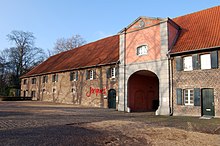

Buderich
House sea
The tea house, which is often referred to as “Meerbusch's landmark”, is located directly on the L 137 , on a corner of the former palace gardens of Haus Meer . The Premonstratensian Monastery, founded by Countess Hildegunde von Meer in 1166, was used as a family castle by the Krefeld silk weaver family von der Leyen after secularization . The main building was destroyed in the Second World War, but the former manor, which is inhabited and used commercially, was preserved alongside the tea pavilion. The historical area has been developed since 1974.
Dyckhof
The Dyckhof in Büderich is a castle that was first mentioned in a document as early as 1393. The baroque spire was added in 1666. The former farm is used as a hotel and restaurant.
Old church tower
The old church tower has been a memorial for the victims of the world wars since 1959 . It belonged to the parish church of St. Mauritius, built around 1200, the main building of which was destroyed by fire in 1891. The council of the former municipality of Büderich decided to award the contract for the memorial to the then relatively unknown artist Joseph Beuys . Inside the tower, he installed a sculpture he called the “resurrection symbol”, which hangs on a long iron chain and takes up the shape of the cross. The oak sculpture is three meters high and two meters wide and hangs on the left side wall of the tower so that the viewer who looks through the gate opening does not directly fall on the sculpture. The double-leaf gate was made from heavy oak planks. The names of 222 Büderich war dead are notched in the right wing.
EUROGA art path
The EUROGA Art Path was set up by the city of Meerbusch on the occasion of the European garden show EUROGA 2002plus. The circular path, entitled Mataré and his students , leads through Büderich to 17 works of art by Ewald Mataré and some of his students. The path begins in a park with the sculptures Bank by Erwin Heerich and Windsbraut by Karl Link. It leads through the Büderich cemetery, which is part of the art trail. In addition to the Peter Rübsam memorial, there are two gravestones created by Ewald Mataré as well as a gravestone each designed by Joseph Beuys (for the family Dr. Fritz Niehaus, Ruth Niehaus's father ), Erwin Heerich and Karl Franke. The outstanding work on the Kunstweg is undoubtedly the memorial for those who died during the two world wars (1959) in the old church tower, created by Joseph Beuys. It consists of the door designed by Beuys with the names of the dead and the resurrection symbol inside the tower. The Mataré fountain , built posthumously according to a design from the 1930s, is located on the Landsknecht . A sculpture by Wolf Spemann and the doors designed by Hermann Focke at the Bethlehem Church are on the way to the Mauritius Church, to which Karl-Matthäus Winter's sculpture Josef and the child is attached.
The 15 works of art presented at the opening were supplemented in 2004 by the former tombstone of Karl Franke's Mataré grave; In addition, a gravestone by Erwin Heerich from 1949 was made public in 2005.
Lank-Latum
In the Lank-Latum district, the water tower built in 1912 with its light steel construction is striking. The tower was built by the West German Celluloid Works, the factory was closed in 1985 and later demolished. The Lanker Teloy mill was built in 1822 and operated until 1912. After a renovation in 1981, the mill, whose blades were completely restored, is used as an exhibition space and event location. The Forstenberg , a terminal moraine from the last Ice Age on the outskirts of Nierst, is a natural monument and one of the highest natural elevations in Meerbusch. The story about the robber Der Fetzer , who, according to tradition, is said to have hidden his treasure on the Forstenberg, is legendary .
Osterath
The Osterath train station was opened in 1856. It is located on the left-hand Lower Rhine route and is noticeable due to the facade made of light-colored wooden panels .
The Osterather mill was operated from 1883 initially with wind and later by steam. The sculptor Will Brüll renovated the mill and used it as a place to live and work.
In 1981 the Osterath electrical store was opened in a former ripple control building on part of the RWE substation . The museum shows exhibits from a hundred years of high voltage technology.
Ossum-Bösinghoven
The St. Pankratius Chapel with a central wing from the 11th century is the oldest originally preserved church in Meerbusch. In 1868 it was expanded with the addition of a choir and in 1911 with a bell tower.
In the immediate vicinity of Ossum-Bösinghoven are the listed Pesch Castle and the two protected mansions Gripswald and Radong .
On the outskirts of Bösinghoven there is also the Geismühle , a 700 year old tower windmill, which formally belongs to Oppum .
traffic
Street:
Meerbusch is connected to three motorways .
- A 52 (Roermond – Essen) with the connection points Büderich (14) and Kaarst Nord / Osterath (12)
- A 57 (Nijmegen – Cologne) with the junction Bovert (16), formerly Meerbusch
- A 44 (Lüttich – Kassel) with the junctions Lank-Latum (28) and Osterath (26)
The highways 44 and 57 cross in the city and form the Meerbusch motorway junction named after the city .
The federal highways 9 and 222 led to January 2008 by Meerbuscher city, but were then graded from national road 137th
Bicycle:
Meerbusch is a member of the working group for pedestrian and bicycle-friendly cities, municipalities and districts in North Rhine-Westphalia and strives to make the city more pedestrian and bicycle-friendly. Most recently, an important bicycle connection was created along the railway line between Düsseldorf-Lörick and Meerbusch Büderich Landsknecht. However, there is still a lot to be done, as cycle facilities have been neglected for decades. Cyclists often have to share narrow sidewalks with pedestrians (e.g. on Dorfstrasse in Büderich). Bike sharing, which is an important addition to public transport, does not yet exist. Large providers like nextbike are only available in Düsseldorf. There is a lack of cross-city concepts that have proven themselves in the Ruhr area.
Train:
National Express stops at Osterath station with the trains of the Regional Express RE 7 (Krefeld - Meerbusch-Osterath - Neuss - Cologne), the NordWestBahn with the RE 10 (Kleve - Krefeld - Meerbusch-Osterath - Düsseldorf).
The Rheinbahn operates local public transport in Meerbusch. The company belongs to the Verkehrsverbund Rhein-Ruhr (VRR). The light rail lines U 70, U 74 and U 76 (Düsseldorf - Krefeld) run via stops in Büderich and Osterath on the route of the former K-Bahn . However, the rail connections will be closed at night. In addition, a number of bus connections are maintained. An important link between the tram and bus is the Haus Meer tram stop , near the mansion of the same name . The Haus Meer transfer hub is served by all bus routes with the exception of the Kaarst – Meerbusch-Büderich – Düsseldorf-Flughafen express bus line and the 832 tangent line.
| line | Line route | Tact |
|---|---|---|
| U 70 | ( Krefeld , Rheinstraße - Krefeld Hbf High-floor operation of the Rheinbahn ; former K-Bahn ; additional express service to line U 76 during peak hours ; not all stops of the U 76 line are served. |
20 min |
| U 74 |
( Meerb. - Osterath , Görgesheide 1 - Hoterheide - Kamperweg - Bovert - Haus Meer 2 - Forsthaus - Büderich , Landsknecht -) D-Lörick 3 - Löricker Straße - Lohweg - Prinzenallee High-floor operation of the Rheinbahn ; Line belongs to the Düsseldorf night network ; Section 1-3: Sa 8-15 pm every 30 min and MF in the morning HVZ twice 3-6; Sections 3–6: different frequency Mon – Fri 9–11 p.m., Sat 8–11 p.m. and Sun 1–3 p.m. every 15 minutes, Sat – Sun 0–4 a.m., Sat 5–7 p.m. and Sun 9 a.m. – 1 p.m. ( and 5–9 am in section 4a / b-6) every 30 min; Non-stop trains between Krefeld and D-Holthausen Mon – Fri 9–11 p.m., Sat 8–23 p.m. and Sun 1–3 p.m. from Krefeld from 3 am as U 74 and from Holthausen from 5 as U 76. |
20 min (3–6) |
| U 76 |
Krefeld , Rheinstraße - Krefeld Hbf - High-floor operation of the Rheinbahn ; former K-Bahn ; In the Düsseldorf night network only one trip to Krefeld and back to Belsenplatz; A special timetable applies during the school holidays. Different frequency: Mon – Fri 9:00 p.m. and Sat – Sun every 30 min. Non-stop trains between Krefeld and D-Holthausen Mon – Fri 9–11 p.m., Sat 8–11 p.m. and Sun 1–11 p.m. from Lörick as U 74 bis Holthausen, back and from Düsseldorf Hbf (Handelszentrum / Moskauer Straße is not served) again as U 76. |
20 min |
| SB 51 |
D-Airport Bf 1 - HVZ : 1-2 every 15 minutes, 2-4 every 30 minutes; Mon – Fri: 1–2 every 30 min, 2–4 every 60 min; Sat every 60 min; further stops only between 3 and 4. |
|
| SB 52 |
Meerbusch-Osterath Bf HVZ every 20 min, Mon – Fri every 30 min, Sat every 60 min; Section 1–2 over the A 44 / airport bridge . |
|
| 071 | Meerbusch Haus Meer |
|
| 829 |
Meerbusch , Haus Meer |
|
| 830 |
Meerbusch - Lank, church - Lank, main street - Auf der Gath - Meerbusch Haus Meer |
|
| 831 | HPZ Uerdingen - Uerdingen Bf - Krefeld Rheinhafen - Krefeld- Gellep-Stratum - Meerbusch - Lank, main street - Auf der Gath - Meerbusch Haus Meer |
|
| 832 |
Osterath, Viersener Straße ← Osterath Bf - Osterath, Bahnhofsweg - Hoterheide |
|
| 839 |
Meerbusch, Haus Meer |
Air:
Meerbusch is also well connected to the aviation network thanks to the nearby Düsseldorf Airport .
Water:
On the eastern city limits of Meerbusch in Langst there is a ferry connection to Kaiserswerth on the right bank of the Rhine . Due to the construction of the airport bridge as part of the expansion of the A 44, the ferry has lost its importance for car traffic.
car sharing
Car sharing has so far not been widespread in Meerbusch. Flinkster has a vehicle on the Dr. Franz-Schütz-Platz. Large providers such as Sharenow limit their business area to Düsseldorf. In combination with the patchy cycle network and the low frequency of public transport, many Meerbus people remain dependent on their cars.
economy
Numerous companies are located in several industrial areas, including Epson , Ernst Rademacher GmbH, Schmidt-Strahl GmbH, Nedap , ATHLON, Bobst Group and Kyocera Document Solutions have established branches in the Mollsfeld office park. Furthermore, the manufacturer of medical products, Medtronic , has its German headquarters here. The extension of the office park is called "Mollsfeld Nord". In this area there is the industrial park "Breite Straße", mainly used as a logistics location, because of the motorway, where the company IMAV-Hydraulik GmbH has its headquarters. To the south, the Mollsfeld area borders on the local hardware store Globus and the Bacher brewery, founded in 1874, which has been renovated since 2010 after its closure in 1980 and has been home to the “Forum for Office Culture” since mid-2010.
The “Fritz-Wendt-Straße” industrial park in Strümp was built around the headquarters of the Wendt GmbH grinding technology company. The Lank industrial area "In der Loh" houses small and medium-sized companies such as Abit GmbH and is characterized by modern architecture in the "Robert-Bosch-Straße" area.
The Meerbuscher retail trade concentrates on several centers or town centers. In Büderich these are, on the one hand, the actual town center around the town hall with Dorfstrasse, Doktor-Franz-Schütz-Platz and parts of Moerser Strasse, and on the other hand, further south, the “Deutsche Eck” at the intersection of Düsseldorfer Strasse and Oststrasse. The Osterath retail center is located around the church square on Hoch-, Kaarster and Meerbuscher Straße. The Lank-Latumer Hauptstraße is partly developed as a pedestrian zone and has a market place with the old schoolyard. The historic market in Lank a few meters further south is less characterized by retail and more by gastronomy. Parts of the town centers of Lank and Osterath are traffic-calmed and cobblestone.
Meerbusch is the municipality in North Rhine-Westphalia with the highest proportion of income millionaires in the resident population (as of 2014).
Infrastructure
Public facilities
The administrative offices of the city of Meerbusch are spread over various administrative buildings. The town hall with the mayor's office is one of several administrative buildings in Büderich. The technical department and the citizen's office, security and environment are located in Lank-Latum, the social and youth department is located in Osterath. Citizens' offices are maintained in the Büderich, Lank-Latum and Osterath districts. The music school is in Strümp, the adult education center in Osterath. Because of the limited space in their own building, both institutions often use school buildings to hold courses. The city library is represented with lending points in Büderich, Osterath, Lank-Latum and Strümp.
There are only specialist hospitals in Meerbusch. Medical care is provided by the hospitals in neighboring cities, in particular the Florence Nightingale Hospital in Düsseldorf-Kaiserswerth.
Meerbusch maintains its own central fire station in Osterath, which is supported by four fire engines and three fire fighting groups from the volunteer fire brigade, each stationed in its own fire station.
education
In the urban area there are
- nine elementary schools
- two grammar schools ( municipal Meerbusch grammar school in Strümp, municipal Mataré grammar school in Büderich)
- a secondary school in Osterath
- a comprehensive school in Büderich
The Osterath grammar school was founded in Osterath in 1968, and after moving to Strümp (1970) it was renamed the Städtisches Meerbusch grammar school , while the former regional grammar school in Büderich was transferred in 1979 as the Mataré grammar school from the Neuss district to the sponsorship of the city of Meerbusch. In 1989 the council decided to establish a comprehensive school, which began operations in 1990 in the premises of the former Büderich secondary school. In 1995, the renovation of the high-grade PCB-contaminated Astrid-Lindgren-Schule elementary school in Büderich proved uneconomical, so it was decided to demolish it. The classes moved to today's Adam Riese School on Witzfeldstrasse . On July 19, 2013, the former Raphael Förderschule in Strümp disbanded because it had only 80 instead of at least 144 students.
The medicoreha Welsink Academy , with its state-recognized technical schools for physiotherapy and occupational therapy , conducts practical training for its trainees in the St. Mauritius Therapy Clinic.
Personalities
Sports
Since 2013 a place in Meerbusch annual Tennis Tournament of the ATP Challenger Tour place where 43,000 euros are awarded.
The TSV Meerbusch is the largest sports club in the city. The first men's soccer team played in the fifth-class Oberliga Niederrhein for several years .
environment
The main sources of noise affecting the municipality include the roads A 44 (17.2 million vehicles per year), A 52 (32.9 million vehicles per year), A 57 (24.5 million vehicles per year) ), L 137 (6.2 million vehicles / a), the Cologne – Kleve railway line (approx. 60,000 trains / a) and Düsseldorf Airport (up to 262,000 movements / a).
literature
- Peter Dohms (Ed.): Meerbusch. The history of the city and the old communities . Meerbusch 1991
- Christian Jahl : Meerbusch . Leaps in time. Erfurth: Sutton Verlag , 2002, ISBN 3-89702-466-7
- Heimatkreis Lank e. V .: Meerbusch in contemporary testimonies 1930–1950.
- Margot Klütsch: Meerbuscher Kunstwege. Works of art and monuments in the cityscape . Published by the city of Meerbusch. Düsseldorf 2010, ISBN 978-3-89978-132-8
- Paul Derks : In the land of Keldaggouue. Contributions to the Lower Franconian settlement name research in the vicinity of the city of Meerbusch (= Im Rheinbogen, vol. 8). Meerbusch 1999
Web links
|
Further content in the sister projects of Wikipedia:
|
||
|
|
Commons | - multimedia content |
|
|
Wiktionary | - Dictionary entries |
|
|
Wikivoyage | - Travel Guide |
- Website of the city of Meerbusch
- Monuments in the city of Meerbusch
- Train accident near Meerbusch-Osterath on December 6, 2017 on wdr.de
Individual evidence
- ↑ Population of the municipalities of North Rhine-Westphalia on December 31, 2019 - update of the population based on the census of May 9, 2011. State Office for Information and Technology North Rhine-Westphalia (IT.NRW), accessed on June 17, 2020 . ( Help on this )
- ↑ [1]
- ^ City of Meerbusch Statistical Yearbook 2016 , accessed on February 20, 2020
- ↑ Archived copy ( Memento from July 16, 2011 in the Internet Archive )
- ^ Marion Sarna: Excavations during the renovation of the church tower of St. Stephanus in Meerbusch-Lank-Latum . In: Meerbuscher Geschichtshefte , Heft 23, Meerbusch 2006, pp. 89-102.
- ↑ Martin Bünermann: The communities of the first reorganization program in North Rhine-Westphalia . Deutscher Gemeindeverlag, Cologne 1970, p. 114 .
- ↑ Martin Bünermann, Heinz Köstering: The communities and districts after the municipal territorial reform in North Rhine-Westphalia . Deutscher Gemeindeverlag, Cologne 1975, ISBN 3-555-30092-X , p. 39, 40 and 49 .
- ↑ a b The President of the State Parliament of North Rhine-Westphalia (Hrsg.): The power act: Municipal territorial reform in North Rhine-Westphalia . WAZ-Druck, Duisburg 2005, p. 103 ff .
- ↑ EUROGA art path Mataré and his students ( Memento from September 14, 2012 in the Internet Archive ). City of Meerbusch
- ↑ Mataré and his students, Meerbuscher EUROGA-Kunstweg 25 August - 1 September 2002, published by Stadt Meerbusch, Meerbusch 2002.
- ↑ We in Meerbusch. Retrieved August 12, 2020 .
- ↑ Anke crown Meyer, Julia Brabeck: Lörick: bike path Böhler road ends in nothingness. Retrieved August 12, 2020 .
- ↑ nextbike | Bike rental: Bike rental in Düsseldorf - simply rent a bike - anywhere | nextbike Düsseldorf. Retrieved August 12, 2020 .
- ↑ nextbike | original bike sharing: bike rental in the Ruhr area | metropolradruhr. Retrieved August 12, 2020 .
- ^ RP Online: Meerbusch. The number of millionaires is falling sharply. June 12, 2014. Retrieved November 8, 2016.
- ↑ medicoreha Welsink Academy
- ↑ TuS and ASV will be accessed on April 26, 2020 at TSV Meerbusch , rp-online.de
- ↑ Archived copy ( Memento from March 4, 2016 in the Internet Archive )



